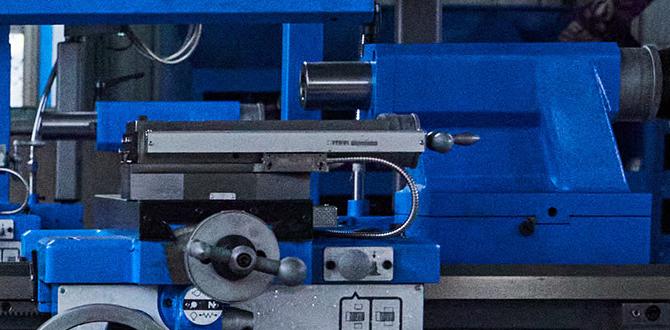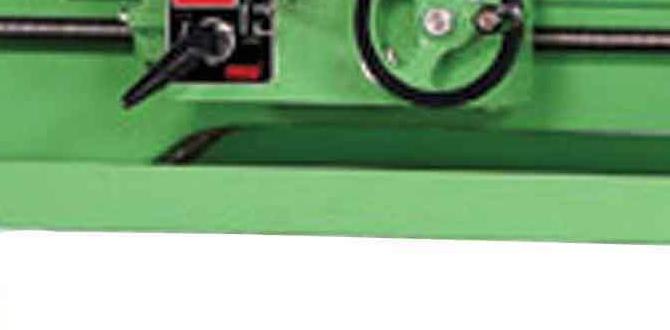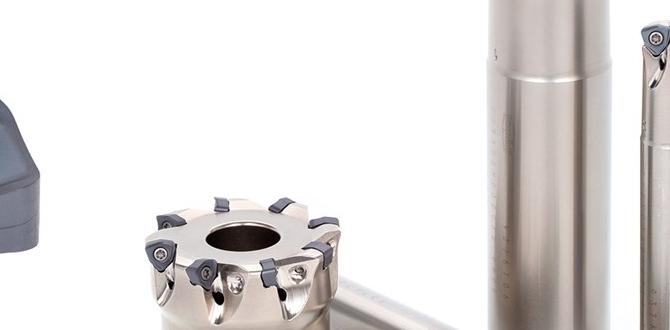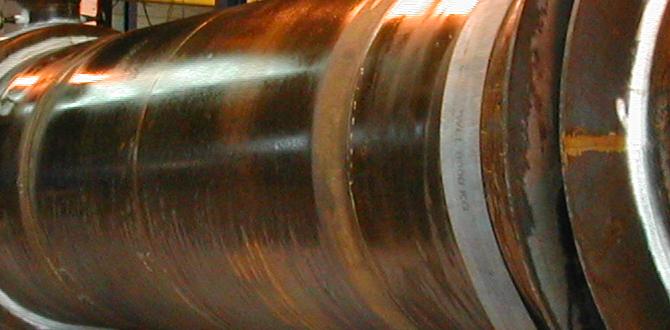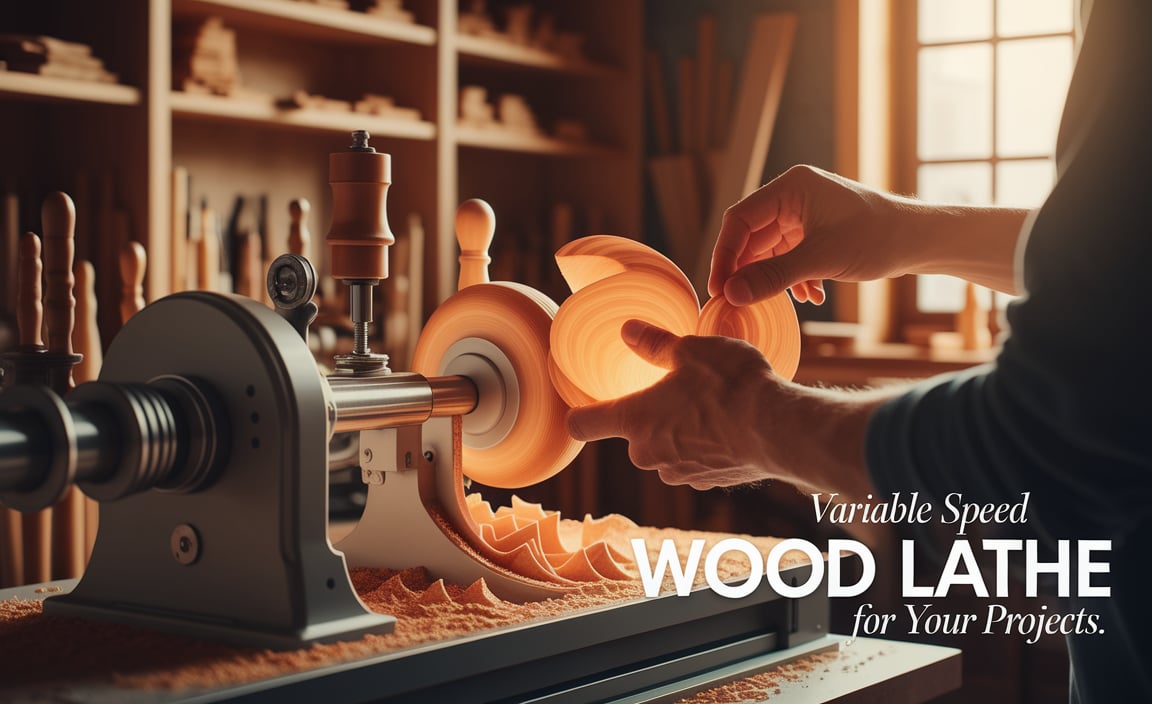A 1/8 inch carbide end mill is crucial for detailed plywood work, offering precision cuts, clean edges, and efficient material removal. It’s the go-to tool for hobbyists and pros tackling intricate designs in plywood.
Working with plywood can sometimes feel like wrestling a stubborn beast. You want crisp lines and smooth edges, but often end up with splintered messes or inaccurate cuts. It’s a common frustration, especially when you’re aiming for detailed projects or precise joinery. The good news is, there’s a simple solution that can transform your plywood projects: the 1/8 inch carbide end mill. This specialized tool is your best friend for achieving professional-looking results without the headache. Stick with me, and I’ll show you exactly why this little tool is so indispensable and how to get the most out of it.
Mastering Plywood: Why a 1/8 Inch Carbide End Mill is Your Secret Weapon
When you’re diving into the world of CNC machining or even hand-held routing for detailed woodworking, the choice of cutting tool makes a huge difference. Plywood, with its layered construction, presents unique challenges. The glue layers and grain direction can easily lead to tear-out and chipping, leaving your work looking rough. This is where a specifically designed tool like the 1/8 inch carbide end mill shines. Its small diameter allows for incredible detail, while its carbide construction ensures durability and sharpness, even when cutting through tough plywood.
Think about those intricate inlays, delicate lettering, or perfectly fitted joints you’ve seen in high-quality projects. Often, the magic behind those details comes down to using the right bit for the job. A 1/8 inch carbide end mill is perfectly sized for these fine details. It’s like having a precision pencil for your CNC machine, allowing you to draw with the cutting edge. We’ll explore why carbide is superior to other materials, what specific features to look for, and how to use this tool safely and effectively to elevate your plywood projects from good to great.
The Power of Carbide: What Makes It So Special?
You might be wondering, “Why carbide? Why not just a regular steel bit?” That’s a fair question! Carbide, specifically tungsten carbide, is an incredibly hard and durable material. This hardness translates directly into a cutting tool that can:
- Stay sharp for longer: Compared to high-speed steel (HSS) bits, carbide stays sharp significantly longer, meaning fewer tool changes and consistent cut quality over time.
- Withstand higher temperatures: Machining generates heat. Carbide’s ability to handle high temperatures without losing its hardness is crucial for efficient cutting and preventing premature wear.
- Cut harder materials: While we’re focusing on plywood, carbide’s strength means it can handle denser woods and even some softer metals with ease, making it a versatile addition to your toolkit.
- Produce cleaner cuts: The sharp, durable edge of a carbide bit slices through material rather than just scraping it, leading to less tear-out and a smoother finish. This is especially important for plywood.
For plywood, the benefit of a cleaner cut is paramount. The layered structure of plywood demands a sharp, aggressive cutting edge to slice cleanly through the wood fibers and glue lines, minimizing the fuzzy edges and chips that can ruin a project. A 1/8 inch size allows this excellent cutting action in very small areas where larger bits would simply tear out the material.
Understanding the “8mm Shank” and Other Specs
When you see specifications like “carbide end mill 1/8 inch 8mm shank,” it tells you a lot about the tool. Let’s break it down:
- Carbide: As we discussed, this refers to the material – tungsten carbide. It’s the key to durability and sharpness.
- End Mill: This is a type of cutting tool used in milling operations. Unlike drill bits, which are designed to cut axially (downwards), end mills have cutting edges on their sides as well as their tips, allowing them to perform a wide range of operations like pocketing, profiling, and contouring.
- 1/8 Inch: This is the cutting diameter of the end mill. A 1/8 inch (approximately 3.175 mm) diameter is incredibly useful for fine detail work. It allows for tight corners, small text, and intricate patterns that larger bits simply can’t achieve.
- 8mm Shank: The shank is the part of the tool that the collet or chuck holds onto. An 8mm shank is a common size in many CNC routers and milling machines. It’s important to ensure the shank diameter matches your machine’s collet size.
- Extra Long: This feature means the flute length (the part with the cutting edges) and often the overall tool length are increased. This is beneficial for deeper cuts or for reaching into recessed areas without the machine needing to be excessively tall or the workpiece needing to be elevated. For plywood, it can allow for cutting through thicker sheets in one pass or for clearing out deeper pockets.
- Low Runout: Runout refers to the wobble or eccentricity of the cutting tool as it spins. Low runout is critical. It means the tool spins almost perfectly true in its holder. High runout leads to vibrations, an uneven cut, inaccurate dimensions, and premature tool wear. For precision work like detailed plywood cutting, low runout is non-negotiable.
These specifications, when combined, paint a picture of a tool designed for precision and detail in demanding materials. The precision measurement and metrology standards relevant in manufacturing are directly impacted by tools with low runout.
Why 1/8 Inch is PERFECT for Plywood
Plywood is fantastic for a multitude of projects, from furniture and cabinetry to intricate decorative pieces and functional jigs. However, its construction always presents a risk of splintering and tear-out, particularly along the edges and in corners. This is where the 1/8 inch diameter becomes your best friend:
- Intricate Detail: Its small size allows it to create sharp, internal corners where larger bits would have to leave a radius. This is essential for detailed engraving, text, and complex geometric patterns.
- Reduced Tear-Out: A smaller diameter generally means less force is required to cut through the material. When combined with carbide’s sharpness, this significantly reduces the risk of splintering and chipping, especially in the cross-grained layers of plywood.
- Smooth Edge Finish: The precise cutting action of a sharp carbide bit at this diameter results in exceptionally clean edges, often minimizing or eliminating the need for extensive sanding.
- Versatility in Thickness: While an 1/8 inch bit is great for detail, many “extra long” versions are available. These allow you to achieve respectable cutting depths in thicker plywood sheets without sacrificing rigidity or needing multiple passes for depth alone.
- Cost-Effectiveness for Hobbyists: For many home woodworkers and hobbyists, investing in a few high-quality 1/8 inch carbide bits is more practical and cost-effective than buying a wide array of larger, less specialized bits.
For example, if you’re designing a custom jig with tight-fitting slots for a specific tool, or creating decorative cutouts for a sign, the 1/8 inch end mill provides the accuracy you need. A larger bit might be too coarse, destroying the fine features you’ve designed.
Choosing the Right 1/8 Inch Carbide End Mill for Plywood
Not all 1/8 inch carbide end mills are created equal. To get the best results from your plywood projects, consider these key features when making your selection:
| Feature | Why It Matters for Plywood | What to Look For |
|---|---|---|
| Material | Carbide offers superior hardness and edge retention compared to HSS, crucial for clean cuts in layered plywood and resisting wear from glue. | Solid Tungsten Carbide |
| Flute Count | More flutes mean more cutting edges, leading to a smoother finish but also requiring more power and potentially slower feed rates. Fewer flutes are often better for softer materials like plywood. | 2-Flute is generally ideal for plywood. 3-flute can also work if your machine has enough power. Avoid 4-flutes for most plywood applications to prevent clogging and heat buildup. |
| Helix Angle | This affects chip evacuation and cutting aggressiveness. | A standard 30-degree helix angle is usually a good all-around choice. Some specialized bits might have steeper or shallower angles for specific materials or operations. For plywood, a balanced angle helps clear chips effectively without excessive force. |
| Coating | Coatings can enhance lubricity, hardness, and heat resistance, extending tool life and improving cut quality. | Uncoated carbide is often sufficient for plywood. However, coatings like Titanium Nitride (TiN) or a Zirconium Nitride (ZrN, often called “red coating”) can provide additional benefits by reducing friction and heat, leading to even cleaner cuts. |
| ZrN (Zirconium Nitride) Coating | This is particularly beneficial for woodworking. It offers excellent lubricity and wear resistance, reducing heat and friction, which is ideal for cutting through the glue lines in plywood. | Look for bits specifically mentioning ZrN coating as beneficial for plastics and wood composites. |
| Overall Length & Flute Length | Extra length is good for deeper cuts or reaching into cavities, but can also lead to reduced rigidity and increased vibration if the tool is too long and slender. | Choose an “extra long” bit if you anticipate needing to cut through thicker plywood (e.g., 3/4 inch) in one pass or clearing deep pockets. Ensure there’s sufficient tool engagement with the collet for rigidity. A balance is key. |
| Runout | Crucial for precision. High runout causes vibration, poor cut quality, and tool breakage. | Look for specifications indicating “precision ground” or a very low runout tolerance (e.g., <0.001"). |
A 2-flute, ZrN coated, solid carbide end mill with a 1/8 inch cutting diameter and an 8mm shank is often considered the “sweet spot” for cutting plywood with a CNC router or milling machine. This combination balances detail capability, clean cutting, chip evacuation, and durability.
The “Extra Long” Feature: When and Why?
The “extra long” designation in a 1/8 inch carbide end mill refers to an increased flute length and often an increased overall tool length. This feature can be a game-changer for specific applications:
- Cutting Thicker Plywood: If you are working with plywood thicker than 1/2 inch (e.g., 3/4 inch or 1 inch), an extra-long end mill allows you to make the cut in a single pass or fewer passes, which can improve efficiency and finish quality by minimizing opportunities for chipping between passes.
- Clearing Deep Pockets: For projects requiring deep recesses or pockets, an extra-long bit can reach the desired depth without needing to raise the workpiece excessively or requiring a very tall machine tool.
- Reduced Possibility of “Stepping Over”: Sometimes, when cutting thick material with a standard length bit, you might need to step over multiple times to get to the full depth. An extra-long bit can reduce the number of these “depth steps,” making the cut smoother and faster.
However, it’s important to be mindful of the trade-offs. An extra-long, slender end mill has less rigidity than a shorter one. This increased flexibility can lead to:
- Increased Vibration: Especially at higher feed rates or with aggressive cuts.
- Wobble (Runout): If not properly supported and used conservatively.
- Tool Breakage: If pushed too hard or if chatter occurs.
For this reason, always use a light finishing pass with an extra-long bit if possible, and ensure your feed rates and spindle speeds are appropriate. A good rule of thumb is to maintain at least half the tool diameter engaged in the collet for optimal rigidity. If your collet is 8mm, and your tool shank is 8mm, you should aim to have at least 8mm of the tool shank fully gripped by the collet.
Getting Started: Safe and Effective Use
Using any cutting tool, especially at speed, requires respect for safety and proper technique. Here’s how to get the most out of your 1/8 inch carbide end mill on plywood, safely:
Safety First: Always
Machining can be dangerous if not approached with caution. Before you even power up your machine:
- Eye Protection: Always wear safety glasses or a face shield to protect your eyes from flying chips.
- Hearing Protection: Milling can be loud. Earplugs or earmuffs are essential.
- Dust Collection: Plywood dust is fine and can be a respiratory irritant. Ensure you have effective dust collection either through your machine or a shop vac.
- Secure Workpiece: Your plywood must be clamped down firmly and securely. Never try to hold it by hand while the machine is running.
- Machine Guards: Ensure all machine guards are in place and functioning correctly.
- No Loose Clothing or Jewelry: These can get caught in moving parts.
- Know Your Machine: Understand its capabilities and limitations.
Setting Up Your Plywood Project
Proper setup is key to a clean, successful cut:
- Material Selection: Higher-quality plywood (like Baltic Birch) with fewer voids and consistent layers will yield better results than cheaper construction-grade plywood. Coated or finished plywood might require slightly different settings or can gum up the bit faster.
- Secure Mounting: Use clamps, a vise, or screws to firmly attach the plywood to your machine’s bed. Ensure there’s nothing beneath the cutting area that the bit could accidentally strike.
- Workpiece Zeroing: Accurately set your X, Y, and Z zero points. The Z-zero is especially critical for the cutting depth.
- Dust Collection: Connect your dust extraction system to the router or spindle.
Optimizing Your Machining Settings (Feeds and Speeds)
This is where many beginners struggle. “Feeds and speeds” refers to how fast the material moves into the cutting edge (feed rate) and how fast the tool spins (spindle speed). These are crucial for achieving clean cuts and not damaging the bit or the material.
For a 1/8 inch (3.175mm) 2-flute carbide end mill cutting plywood, here are some starting points. Always test on scrap material first!
Typical Starting Point for 1/8″ 2-Flute Carbide End Mill in Plywood
| Parameter | Value Range | Notes |
|---|---|---|
| Spindle Speed (RPM) | 18,000 – 24,000 RPM | Higher RPMs can help with chip formation and surface finish, but generate more heat. Start around 18,000 RPM for general plywood. |
| Feed Rate (IPM or mm/min) | 20 – 80 inches per minute (500 – 2000 mm/min) | This is highly dependent on material thickness, machine rigidity, and plunge rate. Start on the lower end (e.g., 40-60 IPM) and increase if cuts are clean and the machine handles it well. |
| Plunge Rate (IPM or mm/min) | 10 – 30 inches per minute (250 – 750 mm/min) | Plunge rate should be significantly slower than the feed rate to prevent the bit from “plunging” into the material and creating excess heat or shock load. |
| Depth of Cut (DOC) | Per pass, typically 0.125″ to 0.25″ (3mm to 6mm) | For 1/8″ bit, avoid taking too deep a cut. For 3/4″ plywood, you’ll likely need multiple passes. A shallower DOC (e.g., 0.125″ or a single pass with a full-depth bit if feasible) results in cleaner edges. |
| Stepover (for pockets) | 10% – 40% of tool diameter (approx. 0.012″ to 0.050″ or 0.3mm to 1.3mm) | A smaller stepover provides a smoother surface finish but takes longer. For detail work, a smaller step
|

